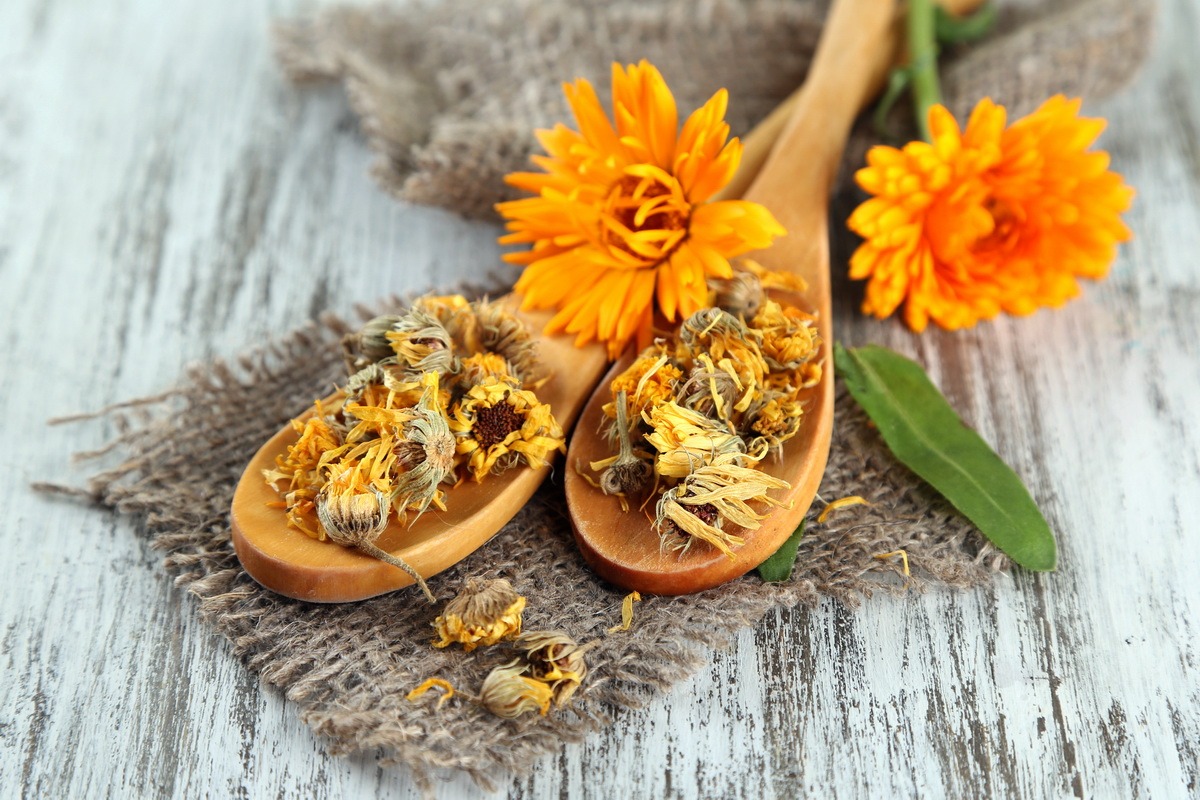Calendula officinalis or marigold is widely used as an ornamental plant. Grown as a medicinal raw material in temperate climates around the world from Europe to Australia.
In the Middle Ages, marigold was used as a spice and as a substitute for saffron, also because marigold was said to have a mood-enhancing effect. Currently, oil extracts of calendula have been introduced in almost all official pharmacopoeias of the world as a bactericidal agent against staphylococci and streptococci, as a sedative, hemostatic, wound-healing and choleretic agent.
In the food industry, marigold oil extract is used to color dairy products, cheese and dough, mainly due to the presence of a stable, fat-soluble yellow marigold pigment.
Calendula CO2 Extract is bright yellow-orange in color and is a viscous liquid with a distinctive floral, bitter odor.

Chart 1. Main components of CO2 extract from Calendula
| NAME | CONTENT IN% OF THE AMOUNT OF VOLATILE COMPONENTS | EFFECT |
|---|---|---|
| Palmitic acid | 12 | Emulsifier, unsaturated fatty acid. |
| Cadiene | 6,2 | Beneficial effect on skin and mucous membranes, healing. |
| Valensen | 4,6 | Painkiller, antiseptic, healing. |
| Kadinol | 3,7 | Recommended as an additive for psoriasis, neurodermatitis, hair loss, skin diseases. |
| Calendulin | 3,5 | Active Antioxidant, Pigment. |
| Lutein | 2,8 | Active antioxidant, increases visual acuity, pigment. |
| Eudesmol | 1,9 | Anti-inflammatory, anti-rheumatic. |
| Myristic acid | 1,5 | Active transdermal transporter. |
| Geneicosan | 0,5 | Estrogen. |
Traditionally, oil preparations based on Calendula officinalis occupy an important place in dermatology and cosmetology, as they are among the most effective. Calendula CO2 extract is recommended for use in cosmetic and pharmaceutical products with the following spectrum of activity:
- Antiphlogistic
- soothing for skin lesions
- Softening of the skin and mucous membranes
- wound healing
- for the treatment of bedsores, scars
- to combat varicose veins and capillaries on the skin, including the skin of the face
- to prevent nipple sores in nursing mothers
- as a tonic for mature skin• in sunscreens against sunburn• in massage creams
Calendula CO2 extract is also recommended to soothe irritation, including on children’s skin.
Chart 2. Application rates, recommendations for use and storage of CO2 extracts
| Food usage rates | The recommended range of use for the most popular 10% oil solutions of CO2 extracts among technologists in the cosmetic industry (item A10 according to our internal classification) is 0.05-0.5% of the mass of the finished product (0.5-5 g / kg or 0.5-5 kg/ton). For extracts from solutions of other concentrations (A1-A100), the application rates must be recalculated proportionately. |
| Recommendations for use | It is recommended to add CO2 extracts in the final stages of preparation, in the cooling phase of the end product. |
| Storage Instructions | It is recommended to store CO2 extracts in a closed container in a cool room and avoid direct sunlight. |
Historical reference

In medieval Europe, marigold was valued not only as a “spice for the poor” – but also as a substitute for saffron and other real spices that were brought in from afar and were expensive. Because of its unique tart taste that it imparted to dishes, calendula was also highly appreciated by wealthy gourmets.
Well, the very first information about calendula as a medicinal plant was found by the ancient Greek military doctor and philosopher Dioscorides, who lived in the 1st century AD. He used a marigold infusion in liver diseases as a remedy for spasms of internal organs. Dioscorides was mentioned by many subsequent researchers, including Avicenna, a prominent eleventh-century physician. Abu Ali Ibn Sina, better known in Europe as Avicenna, wrote about the properties of calendula in his monumental work The Canon of Medicine (1012-1024):
Azaryun (marigolds). Type: Hot, dry in the third degree. Cosmetics: [Calendula] crushed with vinegar helps with “Fox” disease. Tools with joints: calendula ash with vinegar [useful in] inflammation of the sciatic nerve. Eruption organs: Dioscurides says: “If a pregnant woman touches mountain marigolds or introduces them in the form of candles, childbirth is immediately induced.” Poisons: [Marigolds] help against all poisons and especially bites [of poisonous animals].”